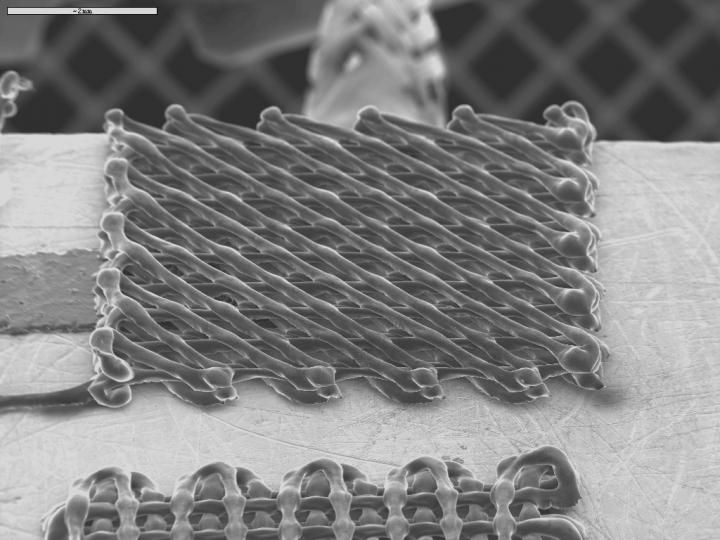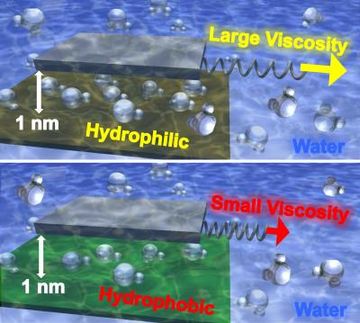3-D printing and nanotechnology, a mighty alliance to detect toxic liquids
carbon nanotubes have made headlines in scientific journals for a long time, as has 3D printing. But when both combine with the right polymer, in this case a thermoplastic, something special occurs: electrical conductivity increases and makes it possible to monitor liquids in real time. This is a huge success for Polytechnique Montréal.

As soon as it comes out of the printing nozzle, the solvent evaporates and the ink solidifies. It takes the form of filaments slightly bigger than a hair. The manufacturing work can then begin.
Polytechnique Montréal
In practical terms, the result of this research, conducted by mechanical engineer Professor Daniel Therriault and his team, looks like a cloth; but as soon as a liquid comes into contact with it, said cloth is able to identify its nature. In this case, it is ethanol, but it might have been another liquid. Such a process would be a terrific advantage to heavy industry, which uses countless toxic liquids.
A simple yet efficient recipe
While deceptively simple, the recipe is so efficient that Professor Therriault protected it with a patent. In fact, a U.S. company is already looking at commercializing this material printable in 3D, which is highly conductive and has various potential applications.
The first step: take a thermoplastic and, with a solvent, transform it into a solution so that it becomes a liquid. Second step: as a result of the porousness of this thermoplastic solution, carbon nanotubes can be incorporated into it like never before, somewhat like adding sugar into a cake mix. The result: a kind of black ink that's fairly viscous and whose very high conductivity approximates that of some metals. Third step: this black ink, which is in fact a nanocomposite, can now move on to 3D printing. As soon as it comes out of the printing nozzle, the solvent evaporates and the ink solidifies. It takes the form of filaments slightly bigger than a hair. The manufacturing work can then begin.
The advantages of this technology
The research conducted at Polytechnique Montréal is at the vanguard in the field of uses for 3D printers. The era of amateurish prototyping, like printing little plastic objects, belongs to the past. These days, all manufacturing industries, whether aviation, aerospace, robotics or medicine, etc., have set their sights on this technology.
There are several reasons for this. Firstly, the lightness of parts because plastic is substituted for metal. Then there is the precision of the work done at the microscopic level, as is the case here. Lastly, with the nanocomposite filaments usable at room temperature, conductivities can be obtained that approximate those of some metals. Better still, since the geometry of filaments can be varied, measures can be calibrated that make it possible to read the various electric signatures of liquids that are to be monitored.
A topical example: pipelines
At the connection points of pipes that form pipelines, there are flanges. The idea would be to factory- manufacture the pipes with flanges coated by 3D printing. The coating would be a nanocomposite whose electric signature is calibrated according to the liquid being transported - oil, for instance. If there is a leak and the liquid touches the printed sensors based on the concept developed by Professor Therriault and his team, an alert would sound in record time, and in a very targeted way. That's a tremendous advantage, both for the population and the environment; in case of a leak, the faster the reaction time, the lesser the damages.
Original publication
Other news from the department science

Get the chemical industry in your inbox
By submitting this form you agree that LUMITOS AG will send you the newsletter(s) selected above by email. Your data will not be passed on to third parties. Your data will be stored and processed in accordance with our data protection regulations. LUMITOS may contact you by email for the purpose of advertising or market and opinion surveys. You can revoke your consent at any time without giving reasons to LUMITOS AG, Ernst-Augustin-Str. 2, 12489 Berlin, Germany or by e-mail at revoke@lumitos.com with effect for the future. In addition, each email contains a link to unsubscribe from the corresponding newsletter.


























































